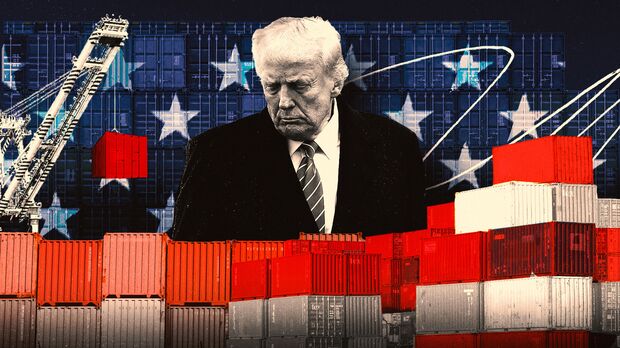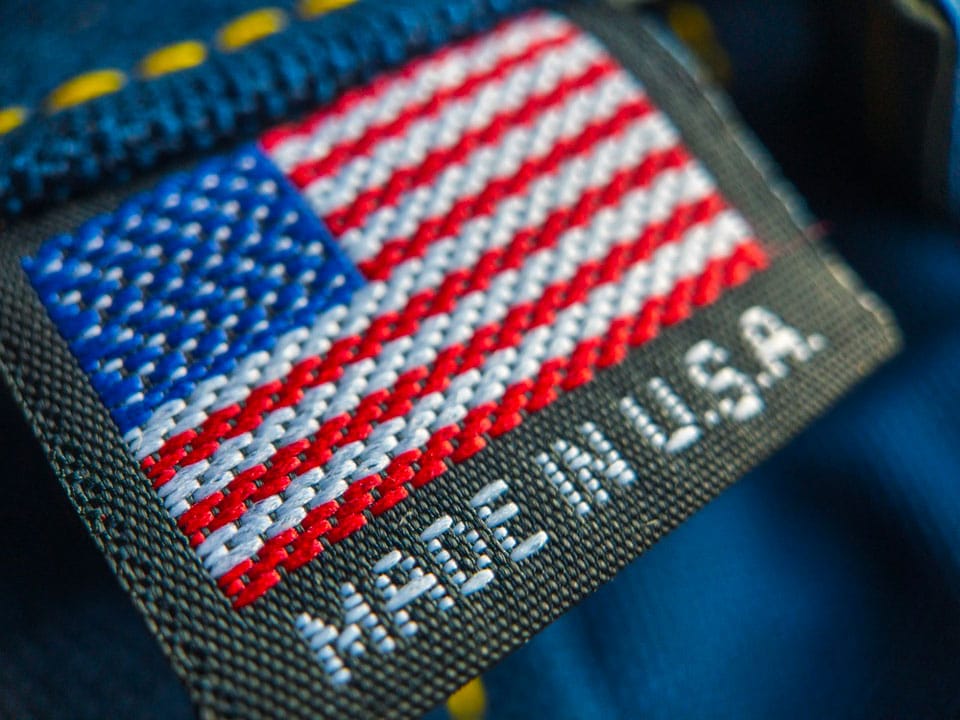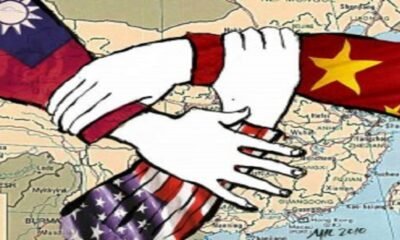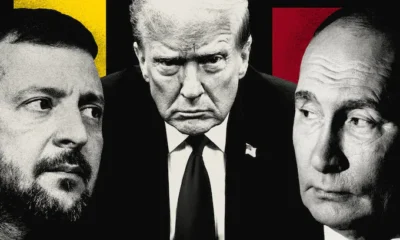Economy
India Cuts Tariffs On US Bourbon! But Do Trump’s Retaliatory Tariffs Mean Cheaper American Goods For Indian Consumers?
Published
7 days agoon
The U.S. government’s decision to slap reciprocal tariffs on countries imposing high duties on American goods—India included—has had markets on edge. Now that the dust is settling, there’s both good and bad news.
First, the good news (and whiskey lovers, you’re in luck!). India has decided to slash tariffs on bourbon whiskey just as Trump amps up his criticism of the country’s trade policies. This is a big win for brands like Suntory’s Jim Beam, which have long been lobbying for lower taxes in India.
Trump, who recently met PM Modi at the White House, has been pushing for “fair trade” and wants to introduce reciprocal tariffs—meaning if India taxes American goods heavily, the U.S. will do the same. But in a surprise move, India went ahead and lowered import duties on bourbon.
A notification from the Indian government on February 13 (which only made waves on Friday) states that bourbon will now attract a total tariff of 100%—down from the earlier 150%. This includes a 50% basic customs duty and another 50% levy. However, this break applies only to bourbon whiskies made and aged in the U.S.—other imported spirits still face the steep 150% duty.
India’s $35 billion liquor market is dominated by giants like Diageo and Pernod Ricard, and they’ve been vocal about India’s sky-high taxes on foreign alcohol. With this cut, American bourbon could become a little more affordable—but whether this is a one-off gesture or the start of broader trade concessions remains to be seen.

Trump’s Tariff War Is Coming for India
While whiskey lovers got a small win, not everyone will be raising a toast—because Trump isn’t cutting India any slack when it comes to reciprocal tariffs.
The U.S. President has made it clear that India won’t get a pass. His latest move to impose retaliatory tariffs on imports is set to intensify the global trade war, and India (along with Brazil) could be among the hardest hit.
Before his recent meeting with PM Modi, Trump doubled down on his criticism, calling India a “hard place to do business” due to its high tariffs. His stance was clear, “Whatever they charge us, we’re charging them.” In his words, it’s a “beautiful, simple system”—though for Indian exporters, it might not feel so beautiful.
What’s at Stake?
Countries like China, India, Vietnam, and Thailand are expected to bear the brunt of these tariffs, making their exports to the U.S. more expensive. And this isn’t just a one-way problem—American consumers could also see higher prices on foreign goods.
Trade numbers paint the bigger picture –
—In 2023-24, India and the U.S. had $119.71 billion in bilateral trade—with $77.51 billion in exports and $42.19 billion in imports, leaving India with a comfortable $35.31 billion surplus.
—Between April and November 2024-25, trade reached $82.52 billion, still tilted in India’s favor with a $23.26 billion surplus.
—The U.S. accounts for 18% of India’s total exports and 10.73% of its total trade, making it a critical partner.
Steel, Food, and Textiles—Who Gets Hit Hardest?
Trump has already announced a 25% duty on steel and aluminum imports (effective March 12), and Moody’s warns this will hurt Indian steel exporters. But that’s just the beginning.
According to trade data, sectors that could face the most heat include –
—Animal products – A 30.2% tariff gap could spell trouble.
—Food and vegetables – High exposure means more expensive exports.
—Footwear, textiles, and chemicals – Could be next in line for higher U.S. tariffs.
—Transportation equipment, minerals, and glass – Also on the risk radar.
According to Capital Economics, India (29%) and Brazil (28%) are expected to face the highest tariff hikes. Following closely are the European Union (25%), the UK (24%), Mexico (23%), and Canada (19%). As a result of these increased import costs, US inflation could rise to 4%.

The One-Up Problem
In 2024, the US recorded a $1.2 trillion goods deficit but maintained a $300 billion services surplus. The country accounts for 17.7% of India’s goods exports, while India contributes only 2.7% to US imports.
Historically, the US has argued that trade deals were designed to lower tariffs. However, the latest strategy under Trump’s administration contradicts this, as it aims to raise tariffs to match those imposed by other nations. The White House plans to tailor import taxes for each trading partner, addressing tariffs, unfair subsidies, and factors that put American manufacturers at a disadvantage.
However, if other countries retaliate, everyday goods in the US could become more expensive, and global trade could slow down.
Will Reciprocal Tariffs Hurt India? GTRI’s Perspective
According to the Global Trade Research Initiative (GTRI), the US government’s plan to impose reciprocal tariffs is unlikely to significantly impact India due to differences in the two countries’ export profiles.
For example, if the US imposes a 50% tariff on Indian pistachios in response to India’s similar tax, India remains unaffected as it does not export pistachios to the US. Additionally, for 75% of US exports to India, the average tariff is below 5%, as noted by GTRI Founder Ajay Srivastava.
On the other hand, Indian exports to the US—especially labor-intensive goods like textiles, garments, and footwear—already face high US tariffs, ranging from 15-35%.
“Given the differences in export profiles, reciprocal tariffs may not have a significant impact… In the new Trump era, India may wait until April to see the US decision on reciprocal tariffs and then respond accordingly, as we did in June 2019,” Srivastava said.
Following discussions with Prime Minister Narendra Modi in Washington, President Donald Trump announced that India would increase its purchases of US oil, gas, and military hardware to help reduce the trade deficit. However, he made it clear that Washington would not exempt New Delhi from reciprocal tariffs.
While the details remain unclear, a limited trade deal on reciprocal tariffs is expected to be announced in April.
Existing Tariff Challenges
The US has already implemented non-reciprocal tariffs of 25% on steel and aluminum. Srivastava pointed out that this is not an ideal time for a free trade agreement (FTA) or full trade pact since the US has shown little respect for such agreements. He cited the Trump administration’s decision to impose tariffs on Mexico and Canada despite the USMCA agreement.
GTRI also highlighted that the US has yet to clarify whether reciprocal tariffs will apply to specific products or entire sectors.
A White House fact sheet dated February 13 noted that while the US applies an average Most Favored Nation (MFN) tariff of 5% on agricultural goods, India’s average MFN tariff stands at 39%. Additionally, India imposes a 100% tariff on US motorcycles, whereas the US only charges 2.4% on Indian motorcycles.
Srivastava warned that unless the US establishes clear criteria—whether product-based or sector-based—its MFN tariff reduction efforts might inadvertently benefit China, which remains the world’s largest supplier of industrial goods.
India-US Trade Relations
Between April and November 2024-25, the US was India’s second-largest trading partner, with total bilateral trade in goods reaching $82.52 billion. This included $52.89 billion in Indian exports to the US, $29.63 billion in imports, and a trade surplus of $23.26 billion in India’s favor.

Will Reciprocal Tariffs Benefit Certain Consumers in India?
The prospect of reciprocal tariffs raises an intriguing question—could some Indian consumers actually benefit from the trade war if certain U.S. products become cheaper?
The answer is complex, as the impact depends on how India responds to U.S. tariff hikes. Here’s how the situation could unfold-
1. Indian Exports to the U.S. Face Tariffs – If the U.S. imposes higher tariffs on Indian goods, Indian exporters could find it harder to sell in the American market. This could lead to an oversupply of these products in India, potentially driving prices down.
For instance, if textiles or auto parts face higher tariffs in the U.S., domestic prices in India might drop due to excess supply, benefiting Indian consumers or local businesses that rely on these inputs. However, this could also hurt Indian manufacturers, leading to job losses or reduced wages in these industries.
2. U.S. Goods in India – To Tax or Not to Tax? – If India chooses not to impose retaliatory tariffs on U.S. goods, then American products could remain at regular or even lower prices due to trade adjustments. This could be advantageous for Indian consumers looking to buy American technology, machinery, or consumer goods.
However, if India retaliates by increasing tariffs on U.S. goods, these products could become more expensive. For example, if India raises import duties on American automobiles, brands like Tesla and Ford might become pricier for Indian buyers. Similarly, an increase in tariffs on American agricultural products such as almonds or apples could raise prices for consumers.
3. Currency and Trade Deals – The cost of U.S. imports in India also depends on broader economic factors like exchange rates and trade agreements. If the rupee strengthens against the dollar, it could make U.S. imports more affordable, offsetting the impact of tariffs. Additionally, if certain American goods continue to be imported under special trade agreements with lower duties, Indian consumers might still access them at competitive prices.
For instance, medical equipment, aircraft parts, and certain industrial goods that India imports from the U.S. under existing trade terms might not see a major price hike unless new tariffs are imposed. On the other hand, if a full-fledged trade war escalates, even these exemptions could be reconsidered, leading to higher costs.
4. Industry-Specific Effects –The effects of reciprocal tariffs will vary across industries such as agriculture, technology and electronics, machinery and industrial goods etc.
The Last Bit
The impact of reciprocal tariffs will be uneven—some goods might become cheaper in India due to surplus supply, while others could become more expensive due to counter-tariffs. The real question is how India decides to retaliate.
If India chooses selective tariff hikes, it could protect key industries while ensuring that essential U.S. goods remain affordable. However, if the tariff war escalates further, Indian businesses and consumers could see higher costs across multiple sectors.
Ultimately, reciprocal tariffs are a double-edged sword. While some consumers might benefit from cheaper domestic goods or certain U.S. imports, the broader economy could suffer from disrupted trade, higher manufacturing costs, and potential job losses in export-driven industries.
You may like
-


Taiwan Gears Up For A Major Military Deal With The US—Trump’s New Taiwan Stand Rattles China! Is Another Ukraine In The Making?
-
Trump’s Bold Gaza Plan Receives Netanyahu’s Backing. Will The World Allow Gaza’s Future To Be Shaped By Foreign Interests, Or Seek A Just Solution For Palestinians?
-


High-Stakes Peace Talks Ahead. Trump Team Leads, Zelenskyy Joins, But Ukraine Faces Tough Concessions—A Betrayal? Even As European Allies Watch In Disbelief
-


Is Trump Right About China Controlling The Panama Canal? Well, Not Exactly!
-


Will Ukraine Get A Raw Deal Despite 3 Years Of War? Trump-Putin Alliance Puts Zelenskyy In A Corner, While Europe Senses Trouble—Can Europe Stop This?
-


From 14 States Suing DOGE To Musk’s Agenda Of Deleting Entire Federal Agencies—DOGE Has Emerged Un-Able To DOGE Drama!
